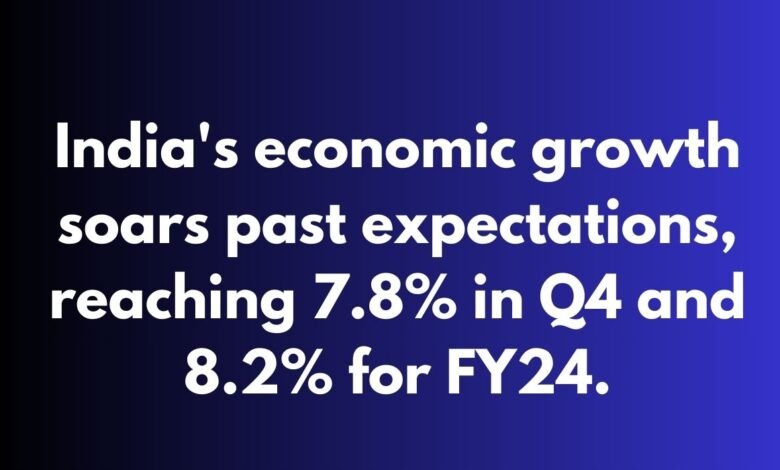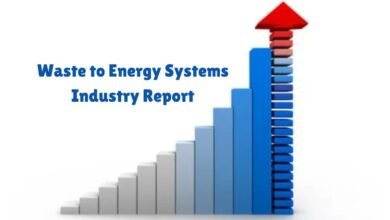Breaking: India’s Q4 GDP at 7.8%, FY24 Growth Reaches 8.2%
India's Q4 GDP rockets past forecasts at 7.8%! Economy surges to 8.2% growth for FY24.

Overview of India’s Q4 GDP Growth: India’s GDP growth in the fourth quarter of the fiscal year has been recorded at an impressive 7.8%, surpassing expectations and showcasing the resilience and dynamism of the Indian economy. This growth rate not only marks a significant improvement over the preceding quarters but also positions India favorably on the global economic stage. When compared to the previous fiscal year, where growth rates fluctuated due to various economic challenges, the 7.8% figure represents a robust recovery and a positive trajectory moving forward.
Key sectors that have significantly contributed to this growth include manufacturing, services, and agriculture. The manufacturing sector, buoyed by increased industrial production and strong domestic demand, saw substantial expansion. The services sector, particularly information technology and financial services, continued to be a major driver of economic activity, leveraging India’s expansive digital infrastructure and a growing consumer base. Meanwhile, the agricultural sector benefited from favorable monsoon conditions and government support schemes, contributing to the overall economic uplift.
Several economic policies have played a pivotal role in fostering this growth. The continued focus on infrastructure development, including significant investments in transportation and logistics, has enhanced connectivity and efficiency. Additionally, reforms aimed at improving the ease of doing business have attracted both domestic and foreign investments, further stimulating economic activity. Fiscal policies, including targeted stimulus measures and tax incentives, have also provided a conducive environment for growth.
Overall, India’s Q4 GDP growth of 7.8% is a testament to the country’s economic resilience and the effectiveness of strategic policy interventions. By fostering a balanced growth across diverse sectors and implementing supportive economic policies, India has successfully navigated the challenges of the global economic landscape, setting a strong foundation for future growth.
Factors Behind the Economic Surge
The Indian economy’s impressive growth of 7.8% in Q4 and 8.2% in FY24 has been driven by a confluence of factors, both domestic and international. Key among these has been the implementation of significant government reforms aimed at enhancing the business environment. Regulatory improvements, tax reforms, and initiatives such as the Goods and Services Tax (GST) have streamlined economic activities, thereby fostering growth. Additionally, schemes like the Production Linked Incentive (PLI) have incentivized manufacturing, further boosting economic output.
Foreign investments have also played a pivotal role in India’s economic surge. The inflow of Foreign Direct Investment (FDI) has surged, thanks to liberalized policies and the government’s proactive engagement with global investors. This inflow has not only provided capital but also brought in technology and best practices, enhancing productivity and competitiveness across various sectors.
Consumer spending has seen a marked increase, driven by rising disposable incomes and improved consumer confidence. The recovery in the job market, coupled with the government’s measures to support employment, has bolstered household incomes. Consequently, sectors such as retail, automotive, and real estate have witnessed robust growth, contributing significantly to the overall GDP.
Technological advancements have been another crucial driver of economic growth. The rapid adoption of digital technologies, spurred by initiatives like Digital India, has revolutionized sectors ranging from finance to agriculture. Enhanced connectivity and digital infrastructure have enabled businesses to operate more efficiently and access new markets, thereby driving economic expansion.
Infrastructure development has also substantially contributed to the economic surge. Massive investments in roadways, railways, and urban infrastructure have not only created jobs but also improved logistics and connectivity. Projects like the Bharatmala and Sagarmala have enhanced trade and transportation efficiency, further fueling economic growth.
In sum, the robust growth of the Indian economy in Q4 and FY24 can be attributed to a synergistic effect of government reforms, increased foreign investments, rising consumer spending, technological advancements, and substantial infrastructure developments. These factors have collectively created a conducive environment for sustained economic expansion.
Implications for the Future
The recent GDP growth of 7.8% in Q4 and 8.2% for FY24 signals a robust economic trajectory for India, exceeding market expectations. This positive momentum sets a promising foundation for the nation’s economic future, with several potential long-term benefits on the horizon. A key advantage of this growth rate is the likely increase in foreign investment. Investors typically seek stable and growing economies, and India’s impressive GDP performance is likely to attract more foreign direct investment (FDI). This influx of capital can spur further economic activities, leading to the creation of new industries and expansion of existing ones.
Job creation is another significant benefit. As businesses expand and new enterprises emerge, the demand for labor will naturally increase. This can help reduce unemployment rates and improve living standards for many Indian citizens. Moreover, a higher employment rate can stimulate consumer spending, further driving economic growth.
However, this economic growth does not come without challenges. One major concern is inflation. Rapid economic expansion can lead to increased consumer demand, which, if not matched by supply, could drive up prices. This inflationary pressure can erode purchasing power, particularly affecting lower-income households. Policymakers need to carefully balance growth with measures to control inflation to ensure sustainable economic development.
Income disparity is another potential issue. While economic growth can create wealth, it does not always distribute it evenly. The benefits of growth may disproportionately favor certain sectors or regions, exacerbating existing inequalities. Addressing this requires targeted policies to ensure that the fruits of economic growth are more equitably shared across different segments of society.
Looking ahead, the growth trends for the next few quarters and fiscal years appear optimistic. Analysts predict that if the current growth momentum is maintained, India could continue to see substantial economic expansion. However, this will depend on various factors, including global economic conditions, domestic policy measures, and the ability to address the aforementioned challenges. As such, while the current GDP growth data is encouraging, a balanced approach will be essential to sustain and enhance India’s economic prospects.
Expert Opinions and Market Reactions
The announcement of a 7.8% GDP growth rate in Q4 has elicited a range of reactions from economists, market analysts, and industry leaders. Many experts view this growth as a positive indicator of the Indian economy’s resilience and potential for sustained expansion. According to Dr. Rajiv Kumar, a noted economist, “The 7.8% growth rate in Q4 is a testament to the robust performance across various sectors, particularly manufacturing and services. It also reflects the success of structural reforms and timely policy interventions.”
Market analysts are similarly optimistic. Anjali Verma, a senior market strategist, commented, “The strong Q4 GDP numbers are likely to boost investor confidence. This growth, coupled with the 8.2% annual growth for FY24, suggests a bullish outlook for the stock market. We can expect increased foreign direct investment and a positive sentiment among domestic investors.”
The impact of this growth rate on different sectors is also noteworthy. The manufacturing sector has shown significant progress, with increased production and higher output levels. Industry leaders in the manufacturing sector, such as Rajesh Mehta, CEO of a leading manufacturing firm, stated, “The growth in GDP is reflective of the strides we’ve made in enhancing productivity and efficiency. The government’s focus on ‘Make in India’ and other such initiatives have played a crucial role.”
Similarly, the services sector continues to thrive, contributing substantially to the overall GDP. Sectors such as IT, finance, and telecommunications have reported steady growth. Neha Sharma, a financial analyst, noted, “The services sector remains a strong pillar of the Indian economy. The consistent performance in IT and finance is a clear indicator of the sector’s robustness.”
The stock market’s response has been largely positive. Major indices have shown a notable uptick following the announcement of the GDP figures. Financial institutions have also adjusted their economic forecasts in light of the new data. For instance, the Reserve Bank of India has revised its growth projections for the coming quarters, reflecting increased optimism about the economic outlook. These adjustments signal a broader confidence in the economy’s trajectory.
FAQ on India’s Q4 GDP at 7.8%, FY24 Growth Reaches 8.2%
What do these figures mean?
- Q4 GDP: This refers to the Gross Domestic Product (GDP) growth rate of the Indian economy in the fourth quarter (Q4) of the financial year 2023-2024 (FY24). A GDP measures the total monetary value of final goods and services produced in a country during a specific period. A growth rate of 7.8% indicates the economy expanded by 7.8% compared to the same quarter in the previous year.
- FY24 Growth: This represents the overall growth of the Indian economy for the entire financial year 2023-2024. At 8.2%, it signifies the economy grew by 8.2% compared to the previous financial year.
Is 7.8% growth in Q4 good?
This growth rate exceeds expectations from analysts, indicating a stronger than anticipated performance for the Indian economy in the last quarter.
Is 8.2% growth for FY24 good?
Yes, 8.2% is a positive growth rate, especially considering the global economic climate. It suggests India’s economy is performing well overall.
What are some factors that might have contributed to this growth?
Several factors could have influenced this growth, including:
- Increased government spending on infrastructure projects
- Robust domestic consumption
- Growth in certain sectors like manufacturing and services
- Recovery from pandemic-induced slowdowns
What are some potential challenges to future economic growth?
Despite positive growth, India’s economy still faces challenges such as:
- Inflationary pressures
- High unemployment rates
- Global economic uncertainties like geopolitical tensions



